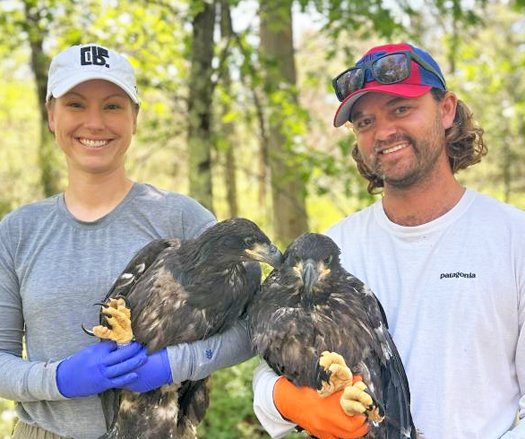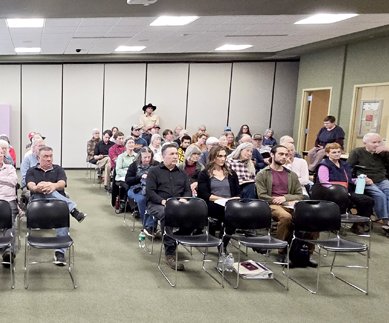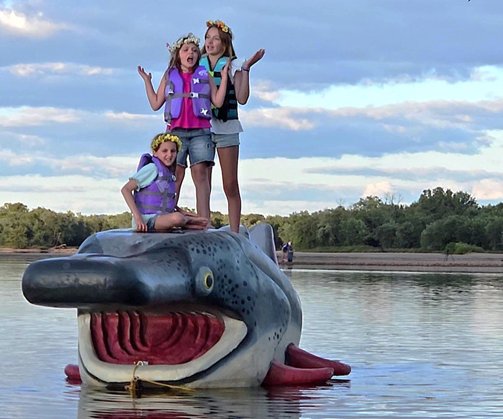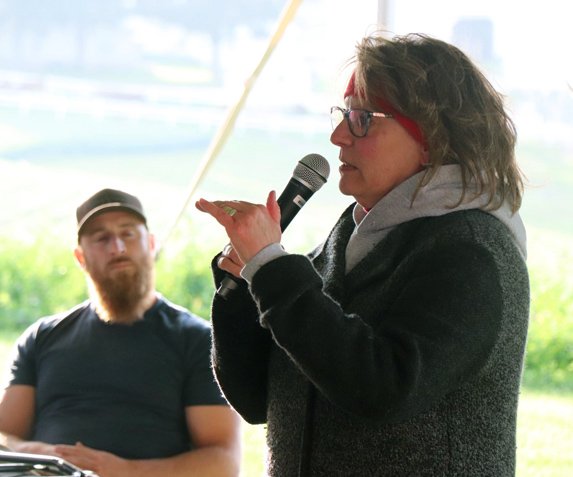WEISTER CREEK - Opening day of trout fishing season, coming up on May 1, is a reason for celebration every year. If you’re lucky and persistent, you can even bag a delicious, wild, spring dinner for yourself of trout, morel mushrooms and ramps.
The Driftless Area is blessed with some of the best cold water trout fisheries on the planet. Those streams are fed from the region’s sandstone aquifers, located deep in the karstic bedrock ‘layer cake’ of the region, keeping the streams cold and clear year round. This means that intrepid anglers can not only hook a big fat brown trout, but also their shyer, smaller native cousin the brook trout.
One of the things that turns a great resource into a spectacular resource is the work of local groups such as the Trout Unlimited Driftless Area Restoration Effort (TUDARE), in combination with the Wisconsin DNR (WDNR) and the county conservation departments. The streambank restoration efforts of these organizations make the stream more accessible for anglers. Those efforts also protect the waters from the headwaters of the creek to the Gulf of Mexico from sediment, erosion and nutrients that can erode water quality and cause life-threatening algal blooms.
Jeff Hastings is one of the grand maestros of streambank restoration and habitat improvement with TUDARE. Formerly, the Vernon County Conservationist for over 20 years, Hastings now writes grant proposals for TUDARE and has developed state-of-the-art habitat enhancement guidelines used widely by other professionals.
“The Driftless Area is one of the highest diversity places on the planet,” Hastings explained. “So, incorporating habitat for non-game species such as birds, frogs, turtles, snakes and more into our projects is a vital way to protect and enhance that diversity.”
Recently, Hastings was able to secure a $9 million grant from U.S. Farm Bill funds, which is funding restoration efforts in the Driftless Region over a multi-year period. These funds have been used in restoration efforts on Tainter and Citron Creeks in Crawford County, and Weister Creek on the Kickapoo Valley Reserve. This year, the funds will be used on Conway Creek in Crawford County, as well as on creeks in Vernon County that were heavily damaged in the 2018 flooding event.
Weister Creek
Hastings, who was recently honored by Wisconsin Trout Unlimited with their highest award, the Resource Award of Merit, joined retiring Kickapoo Reserve Management Board (KRMB) member Paul Hayes, to lead a workshop on the benefits of streambank restoration last Saturday. The workshop, taking place on Weister Creek on the Kickapoo Valley Reserve (KVR), is part of the KVR’s spring ‘Driftless Dialogue’ talks and hikes series.
In his time as a KRMB member, Hayes helped plan, execute and secure funding for the Weister Creek resto-ration project. The project was supported by Trout Unlimited, an organization that Hayes has been a member with since 1970. Hayes was appointed to the Kickapoo Reserve Management Board in 2012, and brought 43 years of experience as a high school science teacher to the job.
The Weister Creek restoration was completed in 2019, but a tour of the almost-complete site in October of 2018 revealed the resilience of efforts like this. Like most streams in the upper reaches of the Kickapoo River, Weister Creek was heavily impacted by the rain event and flash flooding coming from the storm that caused the historic 2018 flood. Touring the area, it was easy to see that the reinforced, sloped banks held up well, and allowed the water to spread out and slow down. The vegetation covering the site was not violently ripped away, but was simply laid down flat and intact.
“Before starting the project, we determined that 80 percent of the sediment getting into the creek was coming from bank erosion,” Hastings explained. “This means that water quality is a huge part of our restoration projects. Pulling the banks back on a gentle slope is key to making the banks stable and helping to mitigate the impacts of flooding on the watershed.”
Hayes said that he had gotten his start in streambank restoration when he was younger, with a project on the Chicago River. When he and his wife, Bernadette, also a retired biology teacher, decided to retire to the Driftless Area, they began to volunteer with Valley Stewardship Network. The two continue to do water quality monitoring on local streams to this day.
“The Weister Creek project got started when a landowner who knew I served on the KRMB, approached me about the problems caused by flooding on the stream,” Hayes remembered. “My wife and I did a lot of water quality sampling up and down the stream to identify the best location for a restoration project.”
Hayes said that there are not only water quality issues that go into determining where a project should be located, but also cultural issues. For instance, he pointed out, one stretch of the stream is owned by the Ho Chunk Nation. Other local residents prefer to fish on stretches of the stream that have not been the site of a restoration effort.
“My work on this project really started with Jeff and TUDARE after the back-to-back flooding events of 2007 and 2008,” Hayes said.
Hastings explained that, with their clear, cold water, Driftless Area streams are almost perfect habitat for trout, but lack just a few crucial things.
“Trout don’t have eyelids, so they need overhead cover and deep pools so they can get out of the sun,” Hastings explained. “This is why, in addition to shaping the banks, our projects will put in structures that help to create deep pools, agitate and oxygenate the water, and create those places along the banks where the trout can hide.”
Hasting said that a WDNR team of fisheries biologists had electroshocked the stream prior to the start of the project, and then again once it was completed. He said that before the project, the team found about 150 fish per mile, and after completion, about 300 fish per mile.
“It used to be that folks in the WDNR thought our Driftless Streams would always be ‘put-and-take’ fisheries, which required stocking to maintain a fishable population,” Hastings said. “But after the 1985 Farm Bill which began to fund restoration efforts, our streams have become wild brown trout fisheries, and wild brook trout will reproduce in some of the smaller, colder feeder streams as well.”
One innovation that Hastings has added into his bag of streambank restoration tricks over the years is to maintain and enhance oxbow or meander areas along the creek bed. These, he says, can be transformed into ideal habitat for tadpoles and turtles. Hastings says that starting in 2022, the Farm Bill will help to fund these kinds of project enhancements, which are intended to increase wildlife habitat and species diversity.
Driftless Dialogues
Upcoming talk/hikes in the Kickapoo Valley Reserve’s Spring 2021 Driftless Dialogue series include:
Saturday, May 8: Spring Ephemerals.Cathy Chybowski, naturalist and life science teacher, will take participants on a walk to look for a profusion of spring ephemerals and more. Learn what an ephemeral flower is, why they are seen in the spring, why they bloom in the woods, and so much more.
Saturday, May 15: Birding.Barbara Duerkson, long-time birder and former Youth Education Coordinator for the Wisconsin Society of Ornithology, will lead a hike that will highlight migration, bird identification, habitat, nesting and territories.
Saturday, May 22: Dam History.Brad Steinmetz, local historian and author, will offer a short presentation on the history of the LaFarge lake and dam project. His talk and hike will feature the amazingly convoluted story of the federal water control project proposed for the Kickapoo River. He has lots of fascinating information on the project to share. This walk meets at camping site AA for a walking tour of the dam.
Saturday, June 5: National Trails Day.Stay tuned for more details on an all-outdoor event focusing on the miles and miles of multi-use trails throughout the Kickapoo Valley Reserve.
Saturday, June 12: Invasive Plants – Identification and Management.Anne Pearce, Invasive Species Outreach Specialist at UW-Madison, will focus on identifying invasive plants and how you can work on invasive plant management throughout the growing season. The talk will feature a short hike from the Visitor Center parking lot.
Saturday, June 26: Riparian Forests, Stream Restoration and Persistent Flooding in the Kickapoo Valley.Eric Booth, Department of Agronomy at UW-Madison, and Caroline Gottschalk-Druschke, Department of English, will utilize the Wolf Valley section of the Weister Creek restoration to see some lingering symbols of flooding and changes to the valley. This talk meets at the intersection of Vernon County P West and Wolf Valley Road.
Hikes are free and open to the public. Due to the need to maintain COVID safety protocols, registration is required at:
www.kickapoo-reserve@krm.state.wi.us.
All talks will meet at the Kickapoo Valley Reserve Visitor Center unless otherwise noted, at S3661 State Highway 131, LaFarge. All talks/hikes will begin at 10 a.m.




